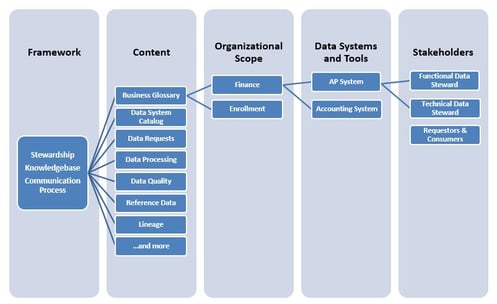In this blog post we will discuss the concept of data governance implementation iterations as well as content creation prioritization and the unexpected return in trust. This involves framework, content, organizational scope, data systems/tools, and stakeholders. When implementing data governance and data intelligence you need to start with why and determine the areas to work on first (see the diagram for an example). And requesting data governance-related information is a good thing.

You are going to look at your overall data governance initiative, and you are going to figure out how you want to prioritize. You need a framework. You need to decide who your data stewards are, where you are going to store this content, how you are going to have requests forwarded to the appropriate individuals, or what are your points of data governance engagement for people. And then you say, what type of content around our data are we going to create first? Are we going to do our glossary, or are we going to do the data system inventory? What about managing requests or doing specifications (on reports or ETLs) or documenting lineage. Just pick those areas, and those will depend on what your goals are, what problems you are trying to solve, and maybe you will do two or three at a time, and you might iterate on content. The other thing that you can choose is to say whether you iterate on content or not, are you going to iterate within your organization. Are we going to iterate on the data systems and tools? We are going to focus just on these systems first, and then maybe which people and stakeholders we are going to try to engage with first.
And how you prioritize these things and how you iterate on this, depends on your organizational capabilities, your resources, your buy-in, your adoption, and your political structure within your organization. And more importantly, the actual goals that you have. You want to structure your implementation to allow yourself to iterate either on content, or organizational scope, or data systems and tools, or a combination. And then, secondly, iterate or prioritize the content creation. Once you decide you are going to do a business glossary, focus on whatever you can automate and bulk import. Get as much information in that can be done easily. Pick as little as possible, but as much as you can, the right balance of seeding the content beyond this, with good examples and training information, but do not worry too much about pushing this too much. Writing content takes effort. Prioritize data governance content creation on requests coming in. Anything new that you are doing, document that as you go, which is another process of request, and then you will end up with that beneficial emergent content. Get more buy-in from the data stewards, authors, and creators. This also gives you an unexpected return in trust with your requesters and consumers. Now, this may seem counterintuitive, but if someone is coming and looking for something, and they cannot find what they need, and they must ask for it, and wait for it and get a response later, isn't that an unsatisfying experience? And we argue, no, it was a satisfying experience.
Here's an example. Say you purchased a scanner. You tried to get it to work. No success. You went to their website and followed their troubleshooting steps. Still no success. The website had the tech support number, so you called up the scanner tech support folks. After a few questions the support person says "You know what? We sent you a bad scanner. We are going to send you another one. In a few days, you'll get a new scanner in the mail." After receipt of new scanner, it worked fine. And because of this experience, you will probably become a loyal consumer of their product because you knew the next step, they interacted with you, and they fixed the problem. In terms of data governance, give your data users a knowledge base where they can find information. If they cannot find what they need, provide them a process to request information that they can receive quickly including access to a subject matter expert. Someone needing information and not finding it easily and not knowing where to go for the information gets frustrated. If people know there is a knowledge base and request process in place it provides them comfort, better trust and increases engagement with the data. You get better engagement from people if you fix a problem, then if there never was a problem before, and it just worked. We are not saying do not have content out there. What we are saying is, do not worry if the way that people get content is by requesting it if you are able to successfully give them that content when they request it.
We hope that this blog post is a reminder that you need to plan your data governance implementation and that it starts with why. Break your efforts into priorities and continue the process including creating data governance content around requests. Additional data governance resources (blog posts, videos, and recorded webinars) can be found at www.datacookbook.com/dg.
IData has a solution, the Data Cookbook, that can aid the employees and the organization in its data governance, data intelligence, data stewardship and data quality initiatives. IData also has experts that can assist with data governance, reporting, integration and other technology services on an as needed basis. Feel free to contact us and let us know how we can assist.
Photo Credit: DGImplementationIterationsDiagram_BP #B1224

